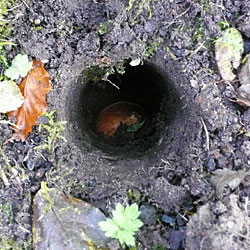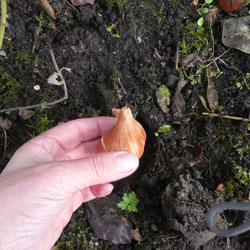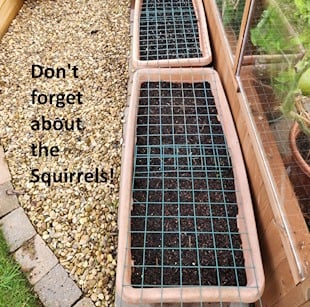



How to plant Spring bulbs
The images show how to plant spring bulbs
The most important thing is to plant them at the correct depth; otherwise, there is a real chance they will not flower.
Key Points
Dig a hole with a bulb planter and plant the bulb at a correct depth, which is 3x the bulb size. See the table below
The pointy end of the bulb goes up.
Replace the earth and fill in the hole and firm it in, after planting.
If you are planting new bulbs, you can use old compost
I find planting spring bulbs much easier with a bulb planter, and preferably a long-handled bulb planter, especially if you are
planting a lot of bulbs. Crocus has a good selection, an affiliate link to Bulb planters.
Most bulbs have a discernible flat end and a pointed end, or nose, as shown in the third top image. It's easy to remember that the flat end goes at the bottom and the pointed nose end points upwards.
Most bulbs, except for Tulips, will reappear each year and flower well.
Planting depths for spring flowering bulbs
If you are planting into the borders, the correct planting depth is important (this does not apply to container planting.)
Cyclamen 2.5 cms (1")
Fritillaria meleagris (snakeshead) 5cms (2")
Crocus, Iris Reticulata, and Scilla 7.5cms (3")
Galanthus Snowdrops 10cms (4")
Muscari 10cms (4")
Hyacinthus 12cms (5")
Narcissus and Tulip 15cms (6")
Planting Spring Bulbs Don't Forget About the Squirrels

Whatever type of spring bulbs you are planting, don't forget about the squirrels. They love bulbs, and will dig them up and squirrel them away for winter feed.
The only way to prevent this is with a physical barrier as in the image.
One year, I planted 50+ tulips in a wall alongside a pond, only to find that only a handful survived the squirrel raid.
A tip when planting Crocus


We all want our Crocus to look like the image on the left, but what if they are more like the flowers on the right? Perhaps you selected your Crocus bulbs to have lovely striped interiors which you didn't see, other than the odd glimpse.
This is because Crocus flowers are sensitive to light. They close their petals at night and open in the morning, but only in the right conditions. If you don't plant crocuses in a sunny spot, or if the spring lacks sunlight, few flowers will bloom. In botanical terms, this is called nyctinasty. It is associated with night and day, but Crocus also close up ( external; video) when the light is poor. Other common plants which do this are Tulip, Californian Poppy, and Morning Glory.
All this group need to be planted in a sunny spot for the best displays.
